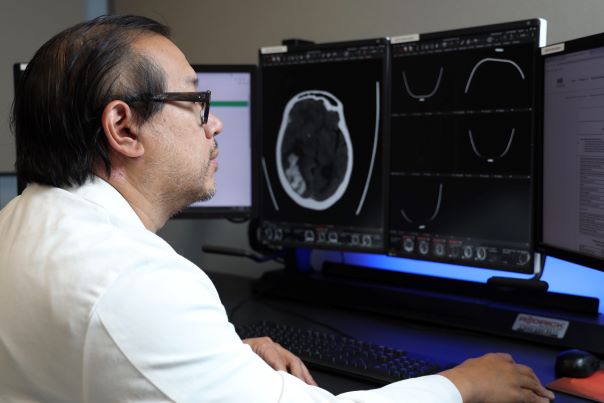Allegheny Health Network’s media relations team is dedicated to providing reporters and other members of the news media with the assistance they need.

Allegheny Health Network Specialists Study Correlation Between Popular Thinners and Brain Bleeding After Head Injury
Doctors at Allegheny Health Network (AHN) conducted a three-year retrospective study of more than 1,000 patients, the results of which have been published in Emergency Radiology. The study found that adults who are taking older blood thinning medications, including clopidogrel (Plavix) and warfarin (Coumadin) have a significantly higher risk of delayed intracranial hemorrhage (ICH) or death following head trauma. The study further showed that taking aspirin along with any blood thinner may increase the risk of delayed brain hemorrhage.
AHN neuroradiologist Warren Chang, MD, who led the study, presented the research at the annual meeting of the Radiological Society of North America in Chicago. Other co-authors of the study included AHN neuroradiologists Michael Spearman, MD, Michael Goldberg, MD, Charles Li, MD, Christian Wanamaker, MD, Albert Sohn, MD, Matthew Kulzer, MD, Tyson Tragon, MD, Brian Weston, MD and Danielle Yin, BS, and Laura Eisenmenger, MD.
An intracranial hemorrhage occurs when blood vessels within the brain rupture, releasing blood into the brain tissue. In a delayed traumatic intracerebral hemorrhage (ICH), bleeding in the brain occurs after the initial trauma, usually within 48 hours, despite having an initial negative CT exam.
Adults taking blood thinners who suffer a head trauma typically undergo CT imaging of the brain. However, the standard of care beyond initial imaging varies. Some hospitals admit patients to the hospital for observation and repeat CT imaging, while others may discharge a patient who does not have an ICH and is in stable condition.
“Different hospital networks have different behaviors for repeat imaging of these patients,” Dr. Chang said.
Hypertension, head injury and use of blood thinners increase the risk of ICH, and the prevalence of patients taking blood thinners is on the rise relative to the aging population.
“Given the high volume of our trauma patients taking aspirin and anticoagulants, this study will help to guide our care of closed head injury patients in emergency medicine and support efforts to use imaging resources appropriately,” said Thomas Campbell, MD, AHN System Chair for Emergency Medicine.
The research team’s analysis included a review of the records of 1,046 patients who were treated at AHN for head trauma between January 1, 2017 and January 1, 2020, and who had an initial negative CT for ICH, followed by repeat imaging. The study group was comprised of 547 women and 499 men with an average age of 77.5 years.
Of the total patients studied, 576 were taking one of the new blood thinners, including apixaban (Eliquis), rivaroxaban (Xarelto), and dabigatran (Pradaxa). The remaining 470 patients were on warfarin, clopidogrel or other similar medication.
Overall, 20 patients (1.91%) suffered a delayed hemorrhage and three patients (0.3%) died; those who died were taking older blood thinners.
Additionally, the research showed that 345 patients were taking blood thinners along with aspirin. Of the 20 patients who had a delayed hemorrhage, 15 were taking an older type of blood thinner and nine of those were also taking aspirin. Furthermore, four of the other five patients who had a delayed hemorrhage were taking aspirin along with newer blood thinners.
“Taking any blood thinner concurrently with aspirin significantly increased the risk of delayed hemorrhage, while taking one of the novel medications without aspirin significantly reduced the risk,” said Dr. Chang.
Based on their findings, the authors recommend that follow-up CT be performed on patients who did not have an initial ICH from head trauma but are on an older blood thinner or are taking any blood thinner along with aspirin. For those who are not on aspirin and are taking a newer blood thinner, follow-up CT is unnecessary unless there are external signs of trauma, according to the researchers.
“This study illustrates how innovative imaging can drive optimal patient care,” said Bethany Casagranda, DO, Chair of the AHN Imaging Institute. “In the end, I believe the recommendations of this work will save many lives.”

